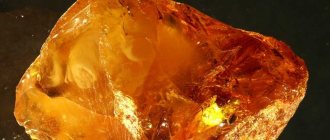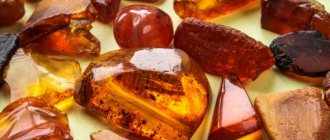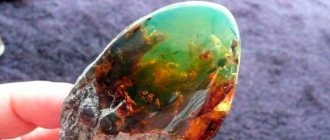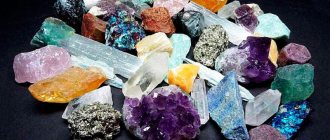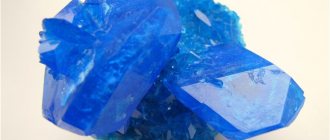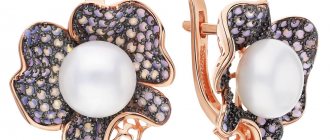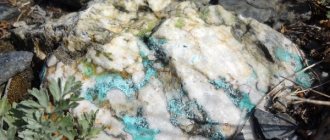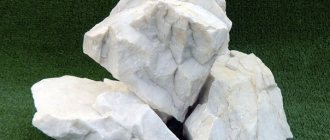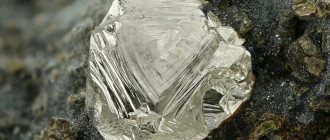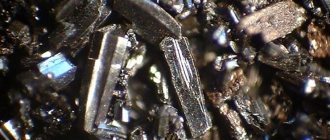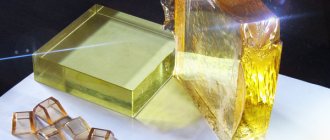The honey-yellow mineral, carried away long ago by sea waves, has been known to people since prehistoric times. It is characterized by an external resemblance to tree resin. Therefore, the origin of amber was not much of a mystery. The ancient philosopher Pliny the Elder hypothesized that this is a fossilized resin. Agricolla and Lomonosov shared the same opinion. Centuries later, views on this theory have changed slightly. However, discoveries have been made that have allowed a new look at the genesis of the solar gem.
Historical reference
Mechanical watch with a rotating dial, in an amber case.
Human use of amber has been known since ancient times. It has been established that amber was known to Upper Paleolithic man: pieces of amber were found inside a dwelling of that time in Mezhirich (Dnepropetrovsk region of Ukraine).
The French name for amber (ambre) was borrowed from Arabic (ʿanbar عنبر). The Arabs considered the stone to be hardened dew that fell from the sky. After its transformation into amber, the word entered many modern Romance and Germanic languages.
Actually, the word “amber” (in the form “entar”), probably borrowed from the Lithuanian language (lit. gintaras), has been known in the Old Russian language since the middle of the 16th century (first attested in 1551). Ukrainian (as a synonym for the word burshtin), Czech, Serbo-Croatian and Slovenian names for amber are already borrowed from Russian.
It has many poetic names - “tears of the sea”, “gift of the sun”, etc.
In ancient times, Aristotle, and after him Theophrastus and Pliny the Elder, assumed that the formation of this stone was associated with the resin of coniferous trees.
In the 18th century, the Swedish naturalist Carl Linnaeus and the Russian scientist Mikhail Lomonosov scientifically proved that amber actually comes from the resin of ancient coniferous trees. M. V. Lomonosov presented new arguments in favor of the organic origin of amber in his works “The First Foundations of Mining Science” and “The Word on the Birth of Metals from Earth Shaking.”
The scientific description, origin and classification of amber (white amber, yellow amber) was given in 1807 by academician Vasily Severgin in the book “Detailed Mineralogical Dictionary”.
Place of Birth
Amber with an insect inside (inclusive)
The championship in honey gem mining belongs to the Baltic. Baltic amber is a very high quality specimen. Jewelry lovers are lucky, because their favorite stone is mined here on an industrial scale, which means there is enough jewelry for everyone.
Dominican amber receives second place in popularity in the jewelry market. It got its name from the deposit - it is mined in the Dominican Republic. But the stone mined in the neighborhood has a different name. The gem coming from Haiti is called Caribbean amber.
Where else are there deposits:
- Canada;
- Mexico;
- Italy;
- Spain;
- Romania;
- Finland;
- Russia;
- Ukraine.
The color of the stone varies depending on the deposit. So, by the shade of the mineral you can easily determine where it was brought from.
Precious protection
A long time ago, “amber” forests grew on the earth. They were adorned with coniferous and broad-leaved trees. Climate change has served to increase the secretion of resin - this is how trees protected themselves from wounds caused by frequent hurricanes and from the penetration of pathogenic organisms through cracks. The resin healed cracks in the bark and places where branches had broken off. And froze forever. This is roughly how amber was formed.
Expert opinion
Semenishcheva Polina
Specialist in mineralogy. Graduated from St. Petersburg Mining University.
Please note : Baltic amber consists of 98% resin from the Pinus sussinifera pine tree.
Physical and chemical properties
Ancient insects in amber
Amber is the hardened resin of coniferous trees. This is an amazingly beautiful stone of natural origin: its physical characteristics differ from other organic minerals.
Amber does not form crystals; it is an amorphous framework polymer. Easy to polish.
Birefringence, dispersion, and pleochroism are absent.
The absorption spectrum cannot be interpreted. Luminescence is bluish-white to yellow-green, in birmite it is blue.
Electrified by friction (negative charge).
Flammable - ignites from the flame of a match. In the open air, it actively oxidizes (aging), which over time leads to changes in the chemical composition, color, and increased fragility.
| Formula | C10H16O+(H2S) |
| Color | Light yellow, brown, red, milky white, greenish |
| Shine | Smolyanoy |
| Transparency | Variable: from almost transparent to completely opaque |
| Hardness | 2-2,5 |
| Cleavage | Absent |
| Kink | Conchoidal; viscous (becomes brittle with aging) |
| Density | Typically 1.05-1.09, maximum 1.3 g/cm³ |
Interesting facts about the yellow mineral
Let's look at some interesting information about this stone:
- Amber is a mineral that was revered by many peoples as a stone of power. For example, Pharaoh Tutankhamun’s crown was decorated with this mineral.
- In Ancient Greece, this gem was considered the stone of the sun.
- Amber often contains inclusions called “inclusions.” These are arthropod insects. They died in a quickly solidifying mass. Thanks to this, it was possible to preserve the smallest details well.
- The ancient Romans had their own version of how the amber stone was formed. These people called the mineral "lincurium". Translated, the name means “lynx urine.” According to legend, amber is believed to be a beautiful stone that was formed from the petrified urine of a representative of the (mountain) cat family.
Varieties of amber
Minerologists divided amber into types. Each has different characteristics and features:
- bokkerite - a dense, elastic, opaque caramel-reddish gem;
Bokkerit
- Glessite is an opaque brown stone with a minimum of impurities;
Glessite
- gedanite - yellow, due to its fragility, processing of the mineral is impossible;
Gedanite
- kissellite - yellow, olive, green agglomerates;
Kiscellite
- kranzite - unripe amber;
Kranzit
- stantienite - fragile, opaque black-brown stones;
Stanthienite
- succinite - dark brown with a rich yellow center, the most common, high-quality type, characterized by a high percentage of succinic acid; recognized as a jewelry variety;
Succinite
- shraufite - yellow-red, red color.
Shraufite
The intermediate variety between succinite and gedanite is called “rotten” (some people call gedanite this way out of ignorance). “Naked” amber stands out - a dense, non-weathered stone, polished with sand from the bottom of the sea. Retained the original color or darkened a little, becoming reddish. The value of amber is influenced by the degree of transparency. It is due to different concentrations of microvoids in the mineral.
Amber resin sometimes contains the remains of flora or fauna. Such inclusions increase the value of the stone. If the insects in the resin are larger than a centimeter, their owner can be considered rich.
Deposits - offshore and onshore
Almost 90% of the world's amber reserves are located in the Kaliningrad region. The stone is mined using an open pit method. Baltic amber is young, no more than 35 million years old.
Almost 90% of the world's amber reserves are located in the Kaliningrad region.
Ukraine (“amber triangle” - Dubrovitsa, Sarny, Klesov)
Sicily
Burma. “Burmite”, old (up to 100 million years old) amber. Findings of stones with inclusions (mainly insects) are frequent.
Sumatra. The stones are young, there are almost no inclusions.
Dominican Republic Blue amber, a very rare variety, is often found here.
Mexico. The age of the stones is comparable to Dominican amber.
The world's deposits are owned by:
- Ukraine (“amber triangle” - Dubrovitsa, Sarny, Klesov).
- Sicily.
- Burma. “Burmite”, old (up to 100 million years old) amber. Findings of stones with inclusions (mainly insects) are frequent.
- Sumatra . The stones are young, there are almost no inclusions.
- Dominican Republic Blue amber, a very rare variety, is often found here.
- Mexico. The age of the stones is comparable to Dominican amber.
Amber mine in Yantarny, Kaliningrad region, Russia
In Alaska, Greenland, the Aleutian Islands, and Russia, sunstone is collected along the frozen shores of cold seas. These yellow-red stones are called sea incense.
Color spectrum
Samples of amber from the Museum of the World Ocean
It is not without reason that amber is called the sun stone. Its classic color scheme is yellow-brownish. There are other shades and types of mineral. The structure and color of amber were created by natural factors of the period when conifer resin flowed onto the soil. From it the organic mineral was formed. The longer the pebble was in the sun or air, the brighter it is.
Gemologists and mineralologists have classified more than 300 colors and shades of gems - from white to black:
- yellow-brown is the most common;
- orange;
- red or the color of ripe cherry - called “dragon’s blood”, similar to a ruby, very rare, expensive;
- white - actually yellowish in color, the illusion of white color is created due to bubble inclusions;
- green - the color of the stone comes from sulfur pyrites or algae;
- colorless - transparent waxy mineral;
- blue—Dominican amber;
- black - dull-opaque, also known as jet.
PURCHASE AND CARE
When buying amber, you must remember that this mineral is easy to fake: sometimes imitations are very beautiful.
Artificial gems are made from natural and synthetic resin, plastic and glass.
Buying amber
How to distinguish natural from pressed
One way to fake a solar mineral is by pressing amber chips. Such a stone (ambroid) will still be natural and much better than a plastic fake, but when a pressed gem is passed off as a solid natural mineral, the price is greatly inflated.
Healing properties
Ancient doctors believed that the sun stone was capable of healing any disease. The methods used for treatment came to us from antiquity. Some information has been lost, but many of the secrets of solar gem healing are still used by lithotherapists today.
Only natural amber can heal a patient.
Having absorbed the power of the earth, the mineral will share it with its owner, cleanse his aura and heal the body.
Amber pendants
How amber can help:
- Weight control. Regularly wearing jewelry with this stone activates metabolism, triggering fat burning. And if you combine it with regular training, the effect will be simply amazing!
- It is believed that the stone neutralizes nicotine, which means it reduces the risk of developing lung cancer. But, of course, if you smoke a pack a day, even such a powerful talisman will not save you.
- Baltic “gold” improves well-being. By purchasing jewelry with hardened resin, you can immediately say goodbye to headaches and migraines.
- Another healing property of the mineral is the improvement of varicose veins. Moreover, it not only removes the symptoms, but also helps fight the problem itself.
- The talisman will be a good prevention against colds. And if you do manage to get sick, it will help you cope with a sore throat and its consequences.
- If you wear the stone so that it comes into contact with the skin, you can get rid of dermatological problems. Rashes and allergies cease to bother those who wear amber rings or pendants.
The healing properties of amber make it possible to make elixirs from it. The stone is ground into crumbs, making a healing tincture from it. It is taken for colds and pulmonary diseases.
How amber helps human health
For a long time, for hundreds of years, amber stone has helped people treat a variety of diseases. As already mentioned, amber smoke is useful in treating diseases of the lungs and nervous system. There is also information that a piece of amber stone will help a person protect the body from the occurrence of kidney stones, or slow down the manifestation of asthma.
Interesting fact: in the eighteenth century, thin plates of amber were made transparent and used to create optical lenses! The second interesting fact was the ability of amber to determine whether a liquid was poisoned or not. If the drink was poisoned, then rainbow stains appeared on the wetted surface of the stone.
White amber was used to treat malaria and even consumption. But what does modern medicine say about amber? It is interesting that in scientific medicine amber is also far from in last place. For example, the acid of the same name is obtained from it.
It is worth noting that our body is capable of producing succinic acid independently, as a product of the vital activity of microorganisms, and is involved in metabolism. Lack of acid negatively affects health and the doctor prescribes it to boost immunity. Taking tablets stabilizes the activity of the blood flow and endocrine system, increases the level of physical activity, and reduces migraines.
Amber acid inhibits the aging of the body at the cellular level. The daily dosage should not exceed 150 grams. If there is a deficiency of succinic acid in the body, you may notice a strong susceptibility to various stresses and rapid fatigue. Acid is useful during pregnancy: by improving hormonal levels, it can reduce toxicosis. Succinic acid also stimulates lactation.
Magical properties of amber
Amber earrings
Alchemists used amber powder to make the elixir of eternal youth. The Slavs wore beads made from the mineral as protection from the evil eye. Crushed stone is still used in churches today to create the desired mood.
The magical properties of the stone are beyond doubt among modern lithotherapists.
- The golden mineral is the embodiment of joy and fun. It pulls the owner out of hopeless melancholy, gives peace, and drives away thoughts of past hardships.
- Black stone is taken on the road to make the trip or business trip easy and successful.
- This same gem sharpens the owner’s intuition and suggests the right decision.
- Amber stone is a woman’s guardian, helping to bear and give birth to a healthy baby.
- Green beads on a red thread are placed in a baby’s stroller or crib from the moment of birth as a shield against the evil eye or trouble.
- The mineral is a powerful home amulet. Protects from the elements, intruders, neutralizes black magic.
- Amber substances restore youth, therefore they are popular among both sexes.
The stone retards the owner’s ailments. The appearance of cracks or other defects means that danger awaits the owner. This is especially important for people in risky professions. Cloudiness signals a person’s illness.
Even the ancient Greeks presented amber items to loved ones or friends as wishes for happiness. This significance of the stone remains today. The gem is worthily appreciated by all people, regardless of age or gender.
A silver ring with jet is considered a talisman for doctors or scientists, copper accessories with black amber - for sorcerers and magicians.
The raw mineral, especially the black one, is the strongest. Sorcerers are confident in the magic of the gem: it protects a person and the house, repels negativity, and imparts determination.
Simple pebbles are better suited as amulets or talismans.
Beliefs about the healing properties of amber
There is an ancient belief that amber was once a kind of indicator for detecting poison in the glasses of rulers. According to him, a piece of amber in the poisoned drink began to crackle and flicker with multi-colored reflections . In addition, in ancient times, the mineral was used to treat mental illnesses, and, thanks to its natural warmth, brilliance and radiance, they gained peace and confidence in their own abilities. Using the mineral as an amulet, they protected themselves from evil spirits and the evil eye.
Talismans, amulets, amulets
Figurine of a turtle made of bronze and amber
This mineral is best worn as a personal item or decoration, cleaned regularly and given a rest. To protect your home, you can purchase a figurine or casket.
In some countries, it is customary to give amber jewelry to loved ones as an amulet and talisman.
Any jewelry is suitable for women, and for men you can present cufflinks, amulet bags made of silver and amber, amber chess for an anniversary, a ring with black amber, a cigarette holder.
You can hang a picture made of amber chips in your home as a talisman.
In the past, an amber bead was hidden in the folds of clothing or in a secret pocket on a child’s clothes, protecting against the evil eye and damage. Even now you can wear beads strung on a red thread.
Amber decoction
It helps overcome many different diseases. From viral-colds to genitourinary and even sexually transmitted diseases. The following ingredients will help us prepare an amber decoction:
- Raw amber – 20 grams;
- Water – 2 liters.
The decoction recipe is very simple. A piece of amber must be crushed into crumbs. Add water and boil. Afterwards, cook over low heat for about forty minutes. Before drinking, the decoction must be cooled. Take half a glass three times a day after meals.
Natural Baltic amber for tincture
Before drinking a decoction of amber, you need to shake it, because all the most useful things are contained in this amber crumb. They need treatment for at least a month.
And if you add amber crumbs to warm milk with honey, you can not only significantly increase your immunity, but also get rid of a hangover.
Areas of application
Necklace "Winter".
1982 Eduard Korbach, chief artist (1991-1992) of the Kaliningrad Amber Factory. Amber, metal. Length - 47 cm. Since ancient times, amber has been used to make all kinds of jewelry and household items. Not only wearable jewelry was made from amber, but also practical items such as cigarette cases, ashtrays, caskets, caskets and even watches. The famous Amber Room occupies a special place in art.
After World War II, the secrets of the craft of creating large amber products were mostly lost. The revival of these traditions in the Baltic countries took different paths.
Also in Russia, various artistic movements emerged. They can be conditionally divided into two “schools” - St. Petersburg and Kaliningrad. The latter appeared as a result of many years of independent practical work with amber, where the natural beauty of the sun stone is valued above all.
Amber is a fragile material; its processing leads to a significant reduction in the initial size and weight of the stones, which in turn leads to an increase in the price of the jewelry.
Currently, there are original processing technologies to give amber the desired color and texture: lightening, heating, heating, chemical treatment, grinding, cutting, stone carving and others. Also especially worth noting is pressed amber.
This or that amber processing technique can be used not only to reveal the natural beauty of the stone, but also to be a tribute to fashion, or to mask defects (layering, cracks, turbidity).
In the old days, to give the necessary purity and shade, amber was heated in fine sand or salt, kept in an oven, or boiled in honey, oil or fat. Ancient family recipes are still used as exclusive recipes in the production of jewelry in the Baltics.
The achievements of jewelers in the amber industry are demonstrated at various trade and exhibition venues, such as Baltic Expo in Kaliningrad (Russia), Amber trip in Vilnius (Lithuania).
Industrial Applications
Small grains, jewelry production waste and contaminated substandard amber are valuable chemical raw materials for the production of succinic acids, oils and rosin used in the perfume, pharmaceutical and paint and varnish industries.
Amber is also an exceptionally good electrical insulator. Amber insulators were used (especially in the 1960s, before the widespread introduction of fluoroplastic) in the ionization chambers of X-ray meters. Typically, fused amber was used - the so-called “ambroid”.
Application in medicine
Even in Ancient Egypt, amber was used to mummify pharaohs. This is due to the fact that amber contributes to the long-term preservation of animal and plant flesh. Amber prevents the destruction of red blood cells (hemolysis) and blood clotting.
Therefore, medical utensils, instruments, and devices related to blood transfusion and blood preservation are made from it.
Application in woodworking
Amber varnish was used as a means of preserving wood. For example, they covered the bottoms of ships, furniture, and the soundboards of musical instruments. The violins of the famous masters Amati and Stradivarius are treated with amber varnish and have retained their melodiousness to this day.
Facts: from Lomonosov to Putin
Lomonosov proved the plant origin of the sunstone: “Amber is a product of the plant kingdom. Anyone who does not accept clear evidence of this kind should listen to what the worms and other reptiles included in the amber say...”
The stone is “afraid” of any chemical influences and should be washed exclusively with running water.
In ancient Rome, to give the stone a red color, it was boiled in honey.
Amber is used not only in pharmaceuticals and jewelry; it is used in various techniques (including in the form of varnish) as an electrical insulator.
Before the New Year V.V. Putin signed a decree criminalizing illegal mining of jade, amber and other semi-precious stones. But the law applies only to those who have previously been subject to administrative penalties for such “pranks.”
Amber can “retain” light, and after walking in the sun wearing jewelry with amber, the stone becomes brighter. However, direct exposure to sunlight is destructive to it.
Amber jewelry
Amber necklace
The most popular area of use is jewelry. Amber is used to create jewelry such as bracelets, brooches, earrings, as well as beads and pendants.
In Soviet times, amber was one of the most affordable jewelry. Crafts and figurines were made from it; almost every beauty had heavy amber beads, a ring, earrings and a brooch. This Soviet wealth is still valued today. They are ready to buy it for fabulous money. From 2000 to 2010, amber prices increased by 900%. He's not going to get cheaper.
The setting for amber can be base metal, silver or gold. The final cost of the jewelry will depend on this. Cast mass-produced items in silver frames are stamped in large quantities and are not expensive. Handmade designer jewelry costs two or three times more.
Particularly popular are beads and bracelets with plants or insects inside the stone. You can also often see such unusual rings.
The main feature of jewelry made from this stone is that it is made by hand.
Beads can serve not only for beauty, but also as a cure for many ailments.
You can find unique souvenir masterpieces made from this gem, such as boxes, keychains, dishes, watches and figures in board games. They not only look beautiful, but also bring abundance and good luck to the home.
Modern approaches to the beneficial effects of amber on the body
Nowadays, alternative medicine also advises the use of amber and its beneficial properties to improve the health of the human body. It is recommended to be worn by pregnant women, as well as people with thyroid dysfunction and colds. In addition to normal wearing, you can also use amber aromatherapy: heat crushed amber in a linen bag in a water bath and breathe over its fumes for several minutes. This method can be effectively used for bronchial asthma and tuberculosis.
How to recognize a fake
- Fake amber jewelry contains a large number of bubbles. They are also found in natural stone, but not in such huge quantities. How can you tell if there are a lot of air droplets or not enough? Just compare the fake with the original.
- Take a closer look at the color. Natural stones are distinguished by smooth transitions.
- Amber stands out among other stones for its lightness. It is so weightless that it seems as if it is not a mineral, but plastic. This feature makes it a little difficult to check, but in this case you can try to scratch it with your fingernail. There should be no scratches left.
- Many stones are advised to be checked with a needle - by scratching their surface. This test is only applicable to hard minerals, and amber is not one of them. Its hardness is only 2-2.5 on the Mohs scale, so you risk spoiling the product and then you will have to buy it anyway.
- The easiest way to check the authenticity of a stone is to rub it on wool. The natural sample becomes electrified. A fake one will not be able to attract dust particles and hair.
Origin story
The origin of amber has long been shrouded in legends, because it is rare to see a stone that does not produce crystals, burns in fire and melts near it. The etymology of the name of such a substance in different languages says a lot about where amber became known in a particular country and what the locals thought about it.
If we turn not to legends, but to history, it turns out that this stone has been used for the manufacture of various products for several thousand years. In the same Baltics, rings, buttons and many other useful things were made from amber back in Neolithic times. Interestingly, the crown of the ancient Egyptian pharaoh Tutankhamun, whose age reaches almost 3.5 thousand years, is decorated, among other jewelry, with amber - scientists believe that it was brought precisely from the shores of the Baltic Sea. Already in those days, a full-fledged trade in this unusual stone was established in the Mediterranean region.
On the eastern and southern coasts of the Baltic Sea, amber processing was a popular folk craft for several millennia, until in the 13th century the Teutonic Order, which reigned here, decided that this was too valuable a raw material to allow anyone to trade it. Since then, the processing of such stones became a state matter, special serfs were engaged in the collection, and processing at home was prohibited - all raw materials were purposefully exported to other cities. The exclusive right to trade such goods had to be obtained from the state, so folk crafts subsided for a long time.
How to store and care for stone
Storing amber is not difficult:
- Avoid contact with perfume, soap or cosmetics.
- Do not throw.
- Store separately, in a box.
- To prevent the stone from darkening, do not leave it in direct sunlight.
- To avoid cracking, avoid sudden temperature changes.
The mineral rarely gets dirty, so it can be cleaned only when necessary.
To do this, tooth powder and paraffin should be taken in equal quantities and mixed until smooth. Then apply to the stone and wipe with a soft cloth.
Questions/Answers
You can talk about “tears of the sea” endlessly. And many questions will arise in an inquisitive mind. Ask them, it will be interesting to find answers!
How to distinguish a fake?
If you are offered a piece of sunstone with an inclusion (spider bug, butterflies or something else) for a small price, think carefully. Inclusions are not common, and their price exceeds even high-quality stones.
We check for authenticity:
- Amber is a warm stone.
- Needle test. The needle will leave shavings on the plastic. The amber will crumble almost into powder. Glass will ignore the needle.
- Baltic amber (unset pebble) will sink in fresh soda, but in sea soda it will remain on the surface.
- Rub the stone vigorously on the cloth. The natural one will heat up and attract fluff, dust particles, and tiny pieces of paper.
- Synthetic fakes melt when heated.
Please note: using a counterfeit banknote detector, you can also detect an amber counterfeit.
How to care?
Almost a living being, this stone of the Sun. And you need to take care of him like a beloved friend.
- Amber does not like the touch of metal or other stones. A good manufacturer of beads and rosaries leaves knots on the thread between the individual stones so that there is no friction. Otherwise, the ambers in these places will turn white.
- No steam cleaners or ultrasound.
- No cosmetics, perfumes, household or other chemicals. Protect your jewelry from oil, grease, and grease. Do not leave in a very hot place.
- Protect your jewelry from sudden temperature changes (for example, from a sauna to ice water).
Wipe off dirt and dust with a damp cloth. Amber is not afraid of water.
How to wear?
Patients with hypothyroidism - in the form of beads or pendants.
Dangling earrings are good against the evil eye.
Some believe that amber is “in tune” with older women; it ages young women. Modern designers don't think so.
You just need to follow certain rules:
- You cannot wear amber in sets. One beads, one earrings, or one bracelet.
- Do not add amber to vintage or retro styles.
- Sunny decorations do not like variegated fabrics. Solid colors are good.
What is the price?
If you want to buy real amber online, solve complex problems.
Here are the prices in one of these stores:
- beads from 3650 to 15800 rubles;
- rosary from 1660 to 28900 rubles;
- bracelets from 1000 to 5000 rubles.
And a cute hand-carved pendant will cost 20,160 rubles.
Now it remains to determine where the amber is natural, where the pressed chips are, and where the vulgar bakelite (synthetic cheap resin) is.
What colors are there?
All shades of yellow:
- white;
- pale yellow;
- deep yellow;
- orange;
- red;
- brown;
- brown.
Sometimes blue, green, and black ambers are found.
Shades of color are given by minerals and substances contained in the resin.
Interesting: experts distinguish about 350 shades of amber.
Where can I buy?
In trusted stores. There they will show you licenses and certificates. It is better not to buy a product at a low price - the money will be wasted.
Buy locally. Usually in such towns there are shops with authentic stones.
The best place to buy blue amber is the Dominican Republic.
There are imitations of blue (the most expensive amber). Here, ordinary amber is simply coated with a special varnish. With it, the stone acquires a delicate blue glow.
What stones does it go with?
Labradorite, carnelian, fluorite, and topaz are suitable for amber.
Some quartz are not compatible with sunstone.
Esotericists do not recommend wearing amber jewelry with hematite, onyx, or heliotrope.
What is inclusion?
In amber, these are the remains of a living organism, stuck in resin and ending its life there. And what didn’t get into the resin!
Found:
- remains of ancient flowers and seeds;
- tree lizard;
- frogs;
- large chameleon (7 cm in length);
- butterflies;
- spiders.
Stones with inclusions can be viewed in Palanga, the Amber Museum; Kaliningrad Museum; at the International Caribbean Museum; in the Dominican Republic (there are several such museums there - there are public and private).
What are imitations made of?
The following is used as an imitation:
- Pressed amber chips. This is not the worst type of imitation (the crumb is real, amber). These things are called ambroids.
- A mixture of rosin, turpentine and shellac. Shellac is the excrement of scale insects living in the tropics and subtropics.
The simplest and cheapest imitations are made from synthetic resins.
Where is the Amber Room?
The one who hid it and the one to whom the secret was entrusted know this. If any of them are still alive... But the general public, since the moment the room went missing (in October 1941), has only been searching and speculating.
And with the loss, everything is somehow murky... At the beginning of the war, they decided not to touch it (very fragile), they mothballed it. Moreover, it was not included in the evacuation plan, and then it was completely unclear where he disappeared. Maybe Stalin was not so wrong when he searched for the enemies of the people with manic persistence?
The Germans carefully packed up the room and took it away within a couple of days. To Koenigsberg (today's Russian Kaliningrad). There it was even mounted in the Royal Castle, but not completely. The area of the allocated hall turned out to be smaller, and several amber panels were stored separately.
In January 1945 (it was clear that the war was lost), they tried to take the room to Germany, but the railway was blocked by Soviet tanks.
This is where the detective story begins. 1945:
- April 6 assault on Koenigsberg by Soviet troops;
- On April 9, the Soviet garrison occupied the castle with the Amber Room located there;
- On April 11, a strong fire breaks out in the dilapidated castle.
No one knows when exactly the room disappeared during this period of time. Well, he doesn't admit it.
And there are several versions:
- Died in a fire. There are good reasons not to believe this.
- Hidden in Kaliningrad (or its environs).
- Died during transportation to Germany.
- It was taken to Germany and hidden there in a cache.
There is a version of the "American trace".
Be that as it may, there is a duplicate of the room, created by wonderful modern craftsmen. However, I would like to see the original...
Compatibility with other minerals
Amber products
Amber is a nugget of Fire. This means that it is absolutely incompatible with Water or Earth. The mineral will suppress earthly energy, and with the water element the effect of mutual destruction is created.
Water minerals are Chrysolite, Alexandrite, Opal, Adularia, Topaz and Emerald.
Earth Stones – Malachite, Turquoise, Jasper, Jadeite and Sardonyx.
Fire brothers:
- pyrite,
- coral,
- zircon,
- spinel,
- pyrope,
- heliodor,
- diamond.
Astrological incompatibility, according to Pavel Globa, is between amber and ruby and hematite, despite the fact that ruby is a stone of Fire.
Climatic conditions for the formation of amber
The amber-forming era coincides with the Paleogene period in the history of the Earth; it lasted approximately three million years. This suggests that the stone could only form under certain paleogeographic conditions.
If we consider the time frame for the emergence of amber, then this process took place 50-55 million years ago. The period, according to scientists, was the warmest in the last five centuries. That's why the resin was released so intensely.
Characteristic features of the era:
- the warm, humid climate of almost the entire planet gradually changed to hot, dry summers and cooler winters in the north;
- zones of the tropics and subtropics, extending to the south and north poles, began to give way to areas of coniferous forests;
- average annual temperatures varied from 25 ℃ to 10-15 ℃.
Despite the trend toward gradual cooling, the climate remained very warm even beyond the Arctic Circle. It turns out that it was precisely these conditions that led to the origin of the substance for the future amber.
Amber and zodiac signs
According to the horoscope, amber is compatible with almost all representatives of the Zodiac circle.
- The combination of fire and water energies makes it suitable for most zodiac signs.
- The exception is Taurus, whose calm and balanced nature does not need additional stabilization.
- The stone has an ideal combination with Leos, whose hot-tempered nature does not interfere with diluting it with harmony and the ability to soberly assess the situation.
- For other zodiac signs, the mineral will become a friend, help in solving life problems and interacting with others.
| Zodiac sign | Compatibility (“+++” is ideal, “+” is good, “-” is impossible) |
| Aries | + |
| Taurus | — |
| Twins | + |
| Cancer | + |
| a lion | +++ |
| Virgo | + |
| Scales | + |
| Scorpion | + |
| Sagittarius | + |
| Capricorn | + |
| Aquarius | + |
| Fish | + |
Who is it suitable for?
Amber is very popular among women as a beautiful and stylish decoration, especially since for many men it is not a big problem to buy it - this gem, which is also not very cheap, falls significantly short of real precious stones. At the same time, representatives of the fairer sex are often interested in astrology and strive to select jewelry in accordance with the rules of this science. Then they should know that the “sun stone” is best suited for the zodiac signs whose element is fire - these are Aries, Leo and Sagittarius.
Since this stone is in any case positive, the same esotericists note the possibility of wearing it for representatives of absolutely any zodiac sign. For some reason, only Taurus is offended by the favor of the “gold of the Baltic” - it’s not that he is forbidden to wear amber jewelry, it’s just that the esoteric effect from it will rush to zero. If for active representatives of fire signs this stone can be an excellent additional stimulant, then for earth signs wearing it can result in a further aggravation of indifference.
Air and water signs can wear such jewelry both for beauty and for a certain healing effect.
This is interesting
- In the 19th century, two pieces of amber weighing 12 and 9.7 kg were found in Prussia.
- The Kaliningrad Regional Amber Museum houses the largest sample of amber in Russia, weighing 4.28 kg.
- One of the largest samples that were found is the Burmese mineral. Its weight is 15.25 kilograms, and the stone itself is kept in a London museum.
- The price depends not only on the color and size, but also on the presence of inclusion. The most expensive amber is a pebble with creatures frozen inside (spiders, butterflies, snails, lizards or frogs). Its price can reach several tens of thousands of dollars.
- There are 3 stones known in the world whose cost exceeds 10 thousand dollars: in the first there is a chameleon 7 cm long, in the second there is a lizard 10 cm long, in the third you can see a frozen frog.
- The famous Amber Room was made for the Prussian king Frederick I, and then became the property of Peter I. During the Great Patriotic War, the room was transported to Tsarskoye Selo, and then disappeared without a trace during the occupation. According to some reports, it was transported secretly by the Germans, but some are convinced that the unique treasure burned down.
Sources and literature
- Amber // Explanatory dictionary of the Russian language (compiled by S. I. Ozhegov, N. Yu. Shvedova). - M., 1992
- Gladky V.D. Amber / Ancient world // Encyclopedic dictionary in 2 volumes. — M.: Tsentrpoligraf. 1998.
- Kostyashova Z.V. Baltic gem // Science and life. - 1999. - No. 5. - P. 43.
- Amber // Geological Dictionary: in 2 volumes / Edited by K. N. Paffengoltz and others. - M.: Nedra, 1978.
- Zoya Kostyashova. “Under the sign of Leo” // Kaliningradskaya Pravda: newspaper. - Kaliningrad, 1998. - August 8. — P. 6.
- Bogdasarov M. A., Bushnev D. A., Golubev E. A., Kovaleva O. V., Shanina S. N. Amber and amber-like fossil resins of Eurasia: Parts 1-2. // News of universities. Geology and exploration, 2008: Part 1: Infrared spectrometry, differential thermal analysis. No. 4. P. 23-30; Part 2: Pyrolytic gas chromatography, gas chromatography-mass spectrometry, amino acid analysis, electron and atomic force microscopy. No. 5. pp. 27-32.
- Loze I. A. Late Neolithic and Early Bronze Age of the Luban Plain. - Riga, 1979.
- Savkevich S. S. Yantar. - L.: Nedra, Leningrad branch, 1970. - 191 p. — 1700 copies.
- Amber on Wikipedia ru.wikipedia.org
5 / 5 ( 14 votes)
Curious cases in Amber production
At the end of the 50s, the Amber Factory sent pressed amber pendants to a trading base in Odessa. Somehow, by chance, amber pendants with inclusions ended up in the batch. These pendants were returned to the plant with the comments “The products are contaminated, do not meet the standards, such products cannot go on sale.”
Amber with inclusions (mosquitoes, midges, moths).
Today, inclusions can be very expensive; some examples on the market fetch from several hundred to several thousand dollars.
